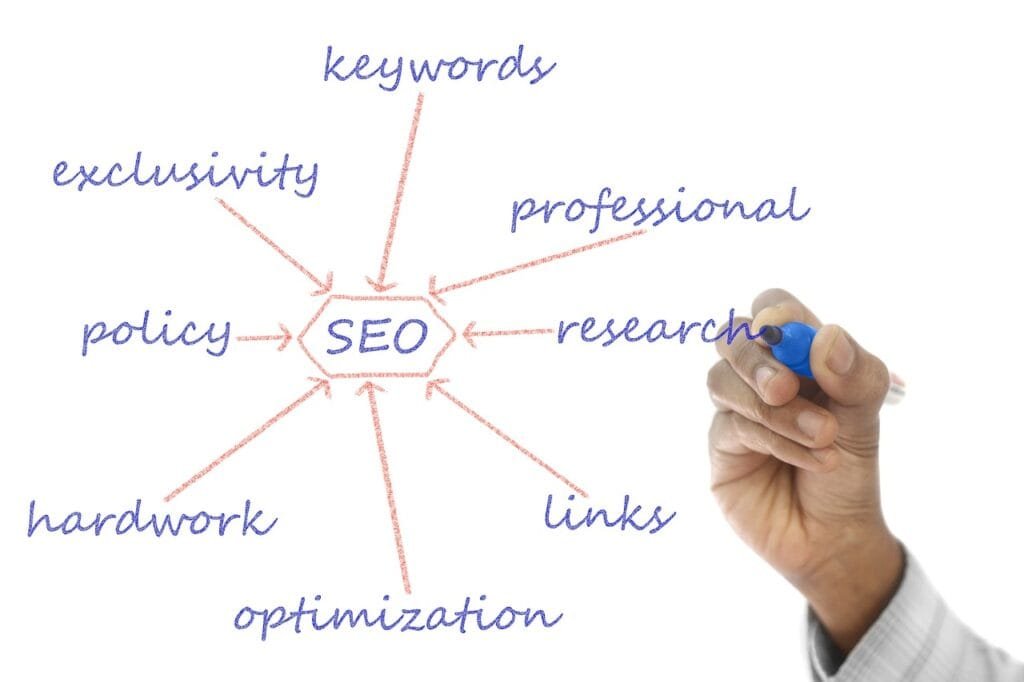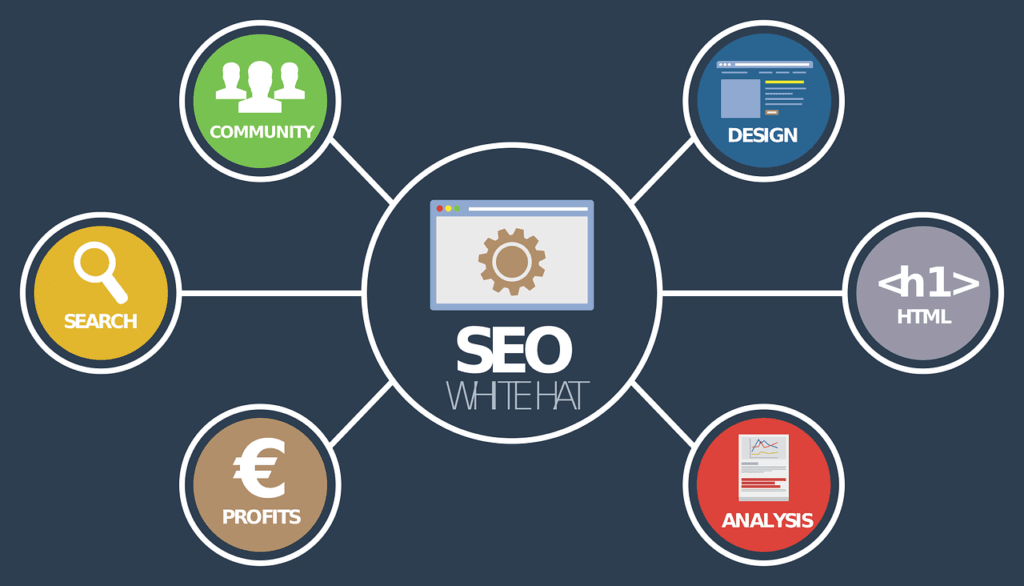This Article has been revised, edited and added to, by Poulomi Chakraborty.
- Foundations of Keyword Mapping
- Tools and Techniques for Effective Mapping
- Crafting the Keyword Map
- Actionable Steps in Keyword Mapping
- Real-World Scenario: A Glimpse into a Startup’s Journey
- Advanced Strategies for Mastering Keyword Mapping
- Local SEO Enhancement
- Conclusion: The Harmonious Symphony of SEO and Website Architecture
In the intricate dance of establishing a digital presence, startups find themselves juggling numerous elements. Amidst this dance, the spotlight often shines brightest on website architecture and SEO. These two critical components, though distinct, are interconnected, with the bridge connecting them being ‘keyword mapping’. This elusive, often overlooked step is instrumental in transforming a startup’s website from a digital storefront to a dynamic platform for user engagement, traffic generation, and conversion optimization.
Effective Keyword Mapping for Startup Website Architecture isn’t just a technical process; it’s an art form where SEO and user experience blend seamlessly, each keyword strategically positioned to enhance website navigability while boosting SEO. Every mapped keyword is akin to a signpost, guiding visitors and search engines alike through the meticulously crafted corridors of the startup’s digital abode.
In this comprehensive guide, we will unravel the layered process of keyword mapping in the context of crafting an intuitive, SEO-friendly, and user-centric website architecture. We’ll explore tools, techniques, and strategies, offering startups a roadmap to weave keywords into the very fabric of their websites, enhancing visibility, engagement, and conversions.
Are you ready to step into this nuanced world where keywords are not just integrated but mapped, where website architecture is not just designed but orchestrated, and where SEO is not just implemented but embodied? If yes, fasten your seat belts, as we embark on this enlightening journey.
Foundations of Keyword Mapping

Keyword mapping is the process of assigning or mapping keywords to specific pages on a website. This strategy is crucial for startups as it lays the groundwork for effective search engine optimization (SEO), driving targeted traffic, and enhancing the user experience.
By meticulously planning your keyword mapping, you’re not just optimizing for search engines but also organizing your website’s content architecture in a way that resonates with your target audience’s search behavior.
Establishing Your Keyword Universe
The first step in keyword mapping is to establish your keyword universe. This involves comprehensive research to identify the terms and phrases your target audience uses when searching for your products, services, or information related to your business.
Utilize a mix of keyword research tools and your insights about your audience to compile a robust list of keywords. Consider the searcher’s intent behind each keyword, categorizing them into informational, navigational, transactional, and commercial intents. This classification helps in aligning your content with the user’s needs at different stages of the customer journey.
Mapping Keywords to Website Architecture
Prioritizing User Experience
As you map keywords to your website’s architecture, prioritize the user experience. Each page should have a clear purpose and target a specific user intent. Start with your homepage and main category pages, assigning broad, high-volume keywords that reflect your startup’s core offerings.
From there, map more specific, long-tail keywords to subcategories and individual product or service pages. Ensure that the hierarchy of information follows a logical flow, making it easy for users and search engines to find and understand your content.
Content Silos and Semantic Relationships
Create content silos that group related content together, strengthening the semantic relationships between pages. This approach not only helps search engines understand the context and relevance of your pages but also enhances the navigability of your site for users.
For instance, a startup selling eco-friendly products might have separate silos for “Eco-Friendly Kitchen Products,” “Eco-Friendly Office Supplies,” and “Eco-Friendly Apparel,” each targeting specific keywords while contributing to the overall theme of eco-friendliness.
Leveraging Internal Linking
Internal linking plays a pivotal role in keyword mapping and SEO. By linking related pages within your website, you distribute page authority and help search engines crawl your site more effectively. Use descriptive anchor texts that include relevant keywords to improve the SEO value of your links. This not only aids in ranking but also guides users to more relevant content, improving their overall experience on your site.
Continuous Optimization and Analysis
Keyword mapping is not a one-time task but an ongoing process that evolves with your startup’s growth and changes in search behavior. Regularly review your keyword map and website analytics to understand how users are interacting with your content.
Identify opportunities to refine your keyword assignments based on performance data and emerging trends in your industry. Continuously optimizing your keyword map ensures that your website remains relevant and competitive in the search landscape.
By following these strategic steps in keyword mapping, startup founders can create a solid foundation for their website’s architecture that serves both user needs and search engine requirements.
The key is to stay user-focused, leverage data-driven insights, and remain adaptable to changes in your market and SEO best practices. This approach not only improves your website’s visibility and traffic but also enhances the user journey, ultimately contributing to your startup’s success.
Tools and Techniques for Effective Mapping
In the realm of keyword mapping, the precision and depth of your keyword research can significantly impact your website’s SEO performance. Leveraging advanced keyword research tools is crucial for uncovering valuable insights into search volume, competition level, keyword difficulty, and searcher intent.
These tools offer a treasure trove of data, from long-tail phrases that capture specific user intents to questions and topics that are trending in your industry. By using these resources, you can develop a more nuanced and effective keyword strategy that aligns with your audience’s needs and your business objectives.
Integrating User Behavior Analysis
Understanding the nuances of your target audience’s search behavior is key to effective keyword mapping. This involves going beyond basic keyword research to analyze how users interact with your site and content. Utilize analytics tools to monitor user behavior metrics, such as bounce rate, time on page, and the pathways users take through your site.
This data provides invaluable insights into the effectiveness of your keyword mapping and content strategy, allowing you to make informed adjustments. By aligning your website’s architecture and content with user behavior patterns, you can enhance engagement, improve user experience, and increase the likelihood of conversion.
Applying SERP Analysis for Competitive Insights
Search Engine Results Page (SERP) analysis is a powerful technique for refining your keyword strategy. By examining the types of content that rank highly for your targeted keywords, you can gain insights into what search engines and users find valuable. This analysis should extend beyond your direct competitors to include any content that occupies your desired SERP space.
Note the common features among high-ranking pages, such as content format, length, and the use of multimedia. Additionally, assess the presence of SERP features like featured snippets, local packs, or knowledge panels. Adapting your content and keyword mapping strategy to target these opportunities can improve your visibility and click-through rates.
Leveraging Topic Clusters for Content Strategy
The concept of topic clusters has become a cornerstone of modern SEO and keyword mapping strategies. This approach involves creating a series of interlinked pages focused on a central theme, anchored by a pillar page that provides a comprehensive overview of the topic. Each cluster page addresses a specific aspect of the topic, targeting related keywords.
This technique not only helps search engines understand the relationship between your pages but also establishes your site as an authority on the subject. By organizing your content into topic clusters, you can improve your site’s structure, enhance the user experience, and boost your rankings for a broad set of keywords.
Harnessing the Power of AI and Machine Learning
As artificial intelligence (AI) and machine learning (ML) continue to evolve, their applications in SEO and keyword mapping become increasingly valuable. AI-powered tools can analyze vast amounts of data to identify patterns, trends, and opportunities that may be difficult to spot manually.
For instance, they can predict shifts in search behavior, suggest untapped keyword niches, or optimize your site’s structure for better performance. By incorporating AI and ML into your keyword mapping strategy, you can stay ahead of the curve, adapting to changes in the search landscape more swiftly and effectively.
By incorporating these advanced tools and techniques into your keyword mapping strategy, startup founders can significantly enhance their website’s architecture and SEO performance.
The key is to maintain a balance between leveraging technology and keeping your target audience’s needs and behaviors at the forefront of your strategy. With a data-driven and user-focused approach, you can build a solid foundation for your online presence, driving traffic, engagement, and growth for your startup.
Crafting the Keyword Map

Creating a keyword map is akin to drafting a blueprint for your website’s content strategy. This foundational document outlines how you will structure your website’s content to align with your audience’s search queries, intentions, and your business objectives. The crafting of a keyword map demands a meticulous approach, where every keyword is strategically placed to guide your content creation, optimize your site’s architecture, and ultimately, improve your search engine visibility.
Identifying Core Themes and Topics
Start by identifying the core themes and topics that resonate with your brand and audience. These themes are broad categories under which your products, services, and expertise fall. Each theme can further be broken down into more specific topics, which will be targeted with individual pages on your site.
This hierarchical structure ensures that your website is organized in a way that is logical to both users and search engines. It also facilitates the grouping of related keywords, making your content more cohesive and authoritative in the eyes of search engines.
Structuring Pages for Intent Alignment
Each page on your website should serve a clear purpose and align with a specific user intent. This means mapping high-intent keywords to pages designed to convert, such as product pages or contact forms, and informational keywords to blog posts or FAQ sections.
By aligning the intent of the keyword with the purpose of the page, you increase the likelihood of satisfying the user’s query, which can lead to higher rankings and better conversion rates. Remember, the goal is not just to attract traffic but to attract the right kind of traffic that will engage with your content and take desired actions.
Visualizing the Keyword-to-Page Relationships
Creating a visual representation of your keyword map can be incredibly beneficial. Use spreadsheets or diagramming tools to plot out how each keyword is linked to specific pages on your site.
This visualization helps you ensure that there is no keyword cannibalization (where multiple pages compete for the same keywords) and that every important keyword is accounted for. It also makes it easier to identify gaps in your content strategy where additional pages or content might be needed.
Prioritizing Keywords Based on Business Goals
Not all keywords are created equal. Some will be more critical to your business goals than others. Prioritize keywords based on factors like search volume, keyword difficulty, and relevance to your products or services.
High-priority keywords should be targeted with your most important pages, such as your homepage or main category pages. Meanwhile, lower-priority keywords, which might still be valuable, can be used for blog posts and other supporting content. This prioritization ensures that your most crucial pages are optimized to attract the most relevant traffic.
Continual Refinement and Evolution
The digital landscape and search behaviors are always changing, and so should your keyword map. Regularly review and update your keyword map to reflect changes in search trends, product offerings, and business objectives.
Use analytics to monitor how well your pages are performing for their target keywords and make adjustments as needed. This iterative process ensures that your website remains relevant and competitive, able to adapt to the ever-changing online environment.
Crafting a comprehensive and strategic keyword map is a critical step in building a successful online presence for startups. By methodically organizing and aligning your content with user intent and search engine optimization best practices, you lay a solid foundation for attracting qualified traffic and achieving your business goals.
Actionable Steps in Keyword Mapping

Embarking on keyword mapping involves more than just understanding the basics of SEO; it’s about laying a strategic foundation for your digital presence. This begins with a thorough analysis of your business goals, target audience, and the competitive landscape. Integrating these insights with SEO best practices will enable you to craft a keyword map that not only drives traffic but also supports your startup’s broader objectives.
Conducting Comprehensive Keyword Research
Diving Deep into Audience Insights
The first actionable step is to conduct comprehensive keyword research rooted in deep audience insights. This involves identifying not just the terms your audience is searching for, but also understanding the context and intent behind these searches. Utilizing a mix of keyword research tools, social media listening platforms, and direct customer feedback mechanisms can provide a 360-degree view of your audience’s needs and behaviors.
Competitor Analysis for Untapped Opportunities
Analyze your competitors’ websites and their keyword strategies to identify gaps and opportunities. This competitive analysis can reveal keywords that are driving traffic to their sites but are underutilized on yours. It’s also an opportunity to identify unique differentiators for your startup that can be highlighted through your keyword choices.
Structuring Your Website with SEO and User Experience in Mind
Aligning Keywords with Site Architecture
Once your keyword research is complete, the next step is to align these keywords with your site’s structure. This involves mapping high-value keywords to existing pages or identifying the need for new pages to capture additional traffic. Each page should be optimized for a unique set of keywords, avoiding overlap that could dilute your SEO efforts.
Optimizing Page Content for Both Users and Search Engines
Optimize each page’s content to ensure it provides value to both users and search engines. This means naturally incorporating target keywords into titles, headers, meta descriptions, and body content. However, the primary focus should always be on delivering quality, informative, and engaging content that addresses the needs of your audience.
Implementing and Monitoring Your Keyword Map
Rolling Out Content and SEO Adjustments
With your keyword map as a guide, begin implementing content updates and SEO adjustments across your website. This might involve reworking existing content, launching new landing pages, or restructuring your site’s navigation to better align with your keyword strategy.
Continuous Monitoring and Iteration
The final step in the keyword mapping process is continuous monitoring and iteration. SEO is not a set-it-and-forget-it endeavor. Use tools to track your rankings, traffic, and engagement metrics for keywords and pages. Regularly review these metrics to identify areas for improvement and adjust your keyword map accordingly. This ongoing process will ensure that your website remains aligned with changing search trends and business objectives.
By following these actionable steps, startup founders can create a keyword map that serves as a dynamic blueprint for their website’s content strategy. This not only enhances visibility and searchability but also ensures that the site’s structure and content are meticulously aligned with the startup’s goals and the audience’s needs.
Real-World Scenario: A Glimpse into a Startup’s Journey
In the dynamic and ever-evolving world of startups, the journey from concept to execution is fraught with challenges and opportunities. This narrative dives deep into the practical application of keyword mapping strategies, illustrating how a fictional startup, EcoTech Innovations, navigated the complex digital landscape to achieve remarkable SEO success and user engagement.
Identifying the Core Mission and Audience
Discovering EcoTech Innovations’ Unique Value Proposition
EcoTech Innovations began with a vision to revolutionize the green technology space with innovative products designed to reduce carbon footprints. The first step in their journey was to clearly define their mission and identify their target audience. Understanding that their primary audience comprised environmentally conscious consumers and businesses looking for sustainable solutions, EcoTech set out to align their digital marketing strategy with this core mission.
Conducting Audience-Centric Keyword Research
EcoTech embarked on an extensive keyword research process, employing a range of tools and techniques to uncover the terms and phrases most relevant to their target audience. This research went beyond mere search volumes; it delved into understanding the searcher’s intent, revealing a demand for not just products but also for educational content on sustainability practices and the impact of green technology.
Crafting a Strategic Keyword Map
Mapping Out the Website’s Structure
With a comprehensive list of keywords at their disposal, EcoTech began the task of crafting a strategic keyword map. This map served as a blueprint for their website’s architecture, ensuring that each page targeted a specific segment of their audience with precision. High-volume, broad keywords were assigned to the homepage and main category pages, while more specific, long-tail keywords found their home in detailed product pages, blog articles, and guides.
Integrating Keywords with User Experience in Mind
EcoTech’s keyword strategy was not just about improving search engine rankings; it was intricately tied to enhancing user experience. By structuring their website in a way that mirrored the audience’s search behavior, they ensured a seamless navigation experience. Internal linking strategies further improved the site’s usability, guiding visitors through a logical journey from general information to specific products and services.
Measuring Success and Iterating for Improvement
Monitoring Performance and Gathering Insights
As EcoTech Innovations launched its keyword-optimized website, the team didn’t just sit back and wait for results; they closely monitored a range of metrics to gauge the effectiveness of their strategy. Using tools to track rankings, traffic, engagement, and conversion rates, they gathered valuable insights into user behavior and search performance.
Iterating Based on Data-Driven Insights
Equipped with real-world data, EcoTech continuously refined its keyword map and content strategy. This iterative process was not a one-time effort but an ongoing commitment to aligning their online presence with both search engine algorithms and user expectations.
By staying adaptable and responsive to the insights gleaned from their metrics, EcoTech was able to maintain a dynamic and effective online strategy that supported their growth and mission.
Lessons Learned: The Power of Strategic Keyword Mapping
EcoTech Innovations’ journey from a startup with a vision to a leader in the green technology space is a testament to the power of strategic keyword mapping. Their success underscores the importance of a well-crafted SEO strategy that prioritizes both search engine visibility and an outstanding user experience.
For startups looking to navigate the digital landscape, EcoTech’s story serves as a valuable case study in the effective application of keyword mapping techniques, highlighting the potential for SEO to drive not just traffic but meaningful engagement and growth.
Advanced Strategies for Mastering Keyword Mapping

For startups looking to carve out their niche in the crowded digital landscape, mastering keyword mapping is not just an option—it’s a necessity. This section delves into the advanced strategies that can take your keyword mapping efforts from good to great, ensuring that your website not only ranks higher in search engine results pages but also resonates with your target audience on a deeper level.
Embracing Semantic Search Optimization
Harnessing the Power of LSI Keywords
Latent Semantic Indexing (LSI) keywords have become a cornerstone of modern SEO strategies. These are terms and phrases related to your primary keywords, offering search engines context about your content.
Incorporating LSI keywords into your content and keyword map enhances your site’s relevance and can improve rankings. Use tools designed to identify these semantic variations and weave them naturally into your content, titles, and meta descriptions.
Structuring Content for Topic Authority
Building topic authority is crucial for startups aiming to establish their expertise in a particular niche. This involves creating comprehensive, authoritative content that covers a topic extensively.
Your keyword map should guide the creation of pillar pages—high-level content pieces that provide a broad overview of a topic—and cluster content that addresses specific aspects in detail. This structure not only aids in organizing your site’s content logically but also reinforces your expertise to search engines and users alike.
Leveraging User Intent for Content Customization
Mapping Keywords to the Customer Journey
Understanding and mapping keywords according to the different stages of the customer journey—awareness, consideration, and decision—can significantly enhance your content’s impact. Tailor your content to meet the needs and questions of your audience at each stage.
This strategy involves creating a diverse range of content, from educational blog posts for the awareness stage to detailed product comparisons and reviews for the decision stage. This ensures that your website caters to potential customers regardless of where they are in the buying process.
Crafting Content for SERP Feature Domination
With the evolution of search engine results pages (SERPs), securing a spot in SERP features like featured snippets, local packs, or “People also ask” sections can dramatically increase visibility.
Analyze the types of SERP features commonly associated with your target keywords and craft your content to align with these formats. For instance, structure content with clear, concise answers for questions likely to appear in featured snippets, or optimize local SEO elements to appear in local packs.
Analyzing and Refining Your Keyword Map
Utilizing Analytics for Continuous Improvement
A successful keyword mapping strategy is never static. It requires continuous analysis and refinement based on real-world performance data. Utilize analytics tools to track how well your pages are ranking for their target keywords, and monitor user engagement metrics to gauge content effectiveness. This data should inform regular updates to your keyword map, ensuring that it evolves to meet changing search trends and user behaviors.
Adopting an Agile Approach to SEO
In the fast-paced digital world, agility is key. Be prepared to pivot your keyword strategy in response to new trends, algorithm updates, or changes in your business model. This may involve experimenting with new keywords, discontinuing underperforming content, or doubling down on strategies that show promise. An agile approach to SEO enables you to stay ahead of the curve and maintain a competitive edge in your industry.
By integrating these advanced strategies into your keyword mapping efforts, your startup can enhance its SEO performance, connect more effectively with your target audience, and achieve sustainable growth in the digital arena. Remember, keyword mapping is both an art and a science, requiring creativity, precision, and ongoing commitment to excellence.
Local SEO Enhancement

In the vibrant ecosystem of startup marketing, local SEO stands out as a crucial component for businesses aiming to establish a stronghold in specific geographic areas. Whether you’re a retail shop, a service provider, or a product-based business with a local focus, enhancing your local SEO through effective keyword mapping can significantly boost your visibility to the community around you. This section explores strategic actions to maximize your local SEO impact, ensuring that your startup not only gets noticed but becomes a preferred choice in your locality.
Building a Robust Local Keyword Foundation
Identifying Geo-Specific Keywords
The journey to local SEO mastery begins with the identification and integration of geo-specific keywords into your keyword map. These keywords combine your primary offerings with local identifiers, such as city names, neighborhoods, or even landmarks.
Tools that offer location-based search insights can provide a treasure trove of information, helping you pinpoint the exact phrases your local audience is using. This granular approach ensures that your content speaks directly to the needs and interests of your community.
Integrating Local Language and Slang
Incorporating local language nuances, slang, and terminology into your content can further align your startup with the community. This strategy goes beyond mere keywords, embedding your brand into the local culture and conversation. It makes your content more relatable and authentic, enhancing engagement and trust among local audiences.
Optimizing for Google My Business and Local Directories
Claiming and Optimizing Your Google My Business Listing
A well-optimized Google My Business (GMB) listing is a powerhouse for local visibility. Ensure your startup’s GMB profile is claimed, accurate, and fully optimized with detailed business information, keywords, and high-quality images. Regular updates and posts can keep your listing active and engaging, increasing its visibility in local searches.
Leveraging Local Directories for Backlinks and Visibility
Expand your local SEO efforts by listing your startup in reputable local directories and platforms specific to your industry. These listings not only provide valuable backlinks but also increase your visibility across different channels where local audiences may seek out services or products like yours. Ensure consistency in your NAP (Name, Address, Phone number) across all listings to boost your local SEO strength.
Crafting Content with a Local Focus
Highlighting Local Events, Stories, and News
Create content that resonates with your local audience by highlighting local events, stories, or news relevant to your industry. This approach not only improves your website’s relevance in local searches but also positions your brand as an active participant in the community. Engaging with local events and narratives demonstrates your commitment to the community, fostering goodwill and loyalty among local customers.
Utilizing Local Customer Testimonials and Case Studies
Integrate testimonials and case studies from local customers into your website. These elements not only serve as social proof but also reinforce your connection to the local area through real stories and experiences. They can be powerful tools for converting potential customers who see the tangible benefits your startup has provided to their neighbors and peers.
Monitoring and Adapting Your Local SEO Strategy
Analyzing Local SEO Performance
Track and analyze your local SEO performance using analytics tools that can segment traffic by geographic location. Monitor how changes to your keyword strategy affect your local search rankings and engagement metrics. This data is invaluable for understanding what works and where adjustments are needed.
Staying Adaptable to Local Market Changes
Local markets can be dynamic, with shifting trends and consumer behaviors. Stay adaptable, updating your keyword map and content strategy in response to new local insights or changes in the community. Engaging with local events, feedback, and trends ensures your marketing efforts remain relevant and effective.
By employing these strategic approaches to enhance your local SEO, your startup can significantly improve its visibility and engagement within the local community. Remember, local SEO is not just about being seen; it’s about becoming an integral and trusted part of the local landscape.
Conclusion: The Harmonious Symphony of SEO and Website Architecture
As we draw the curtains on this insightful journey, the harmonious symphony of SEO and website architecture, orchestrated through effective keyword mapping, stands highlighted. It’s a realm where each keyword becomes a note in this symphony, each webpage a musical piece, and the entire website architecture transforms into a melodious ensemble echoing in the vastness of the digital space.
For startups stepping into this dynamic arena, the roadmap is now laid bare. It’s a path where strategic intent, technological integration, and user-centricity converge, ensuring that every visitor doesn’t just land on a webpage but embarks on a journey. A journey marked by relevance, engagement, and value, leading to not just enhanced visibility but profound connections, loyalty, and conversions.
Read next





















